Was the Regia Aeronautica prepared for WW2? Did they have the equipment, the people, the organization? What were the Italian intentions in the war? How was their Air Force meant to contribute to this? Lets exam the situation just prior to the war declaration.
On 7 June 1940 the following message was transmitted from the Stato Maggiore Grande (SMG) – the Italian Superior Command:
“In confirmation of the communication from today’s meeting of Head of SM, I repeat that the order of the Duce is the following; Keep an absolute defensive attitude towards France (Alps, Corsica, Tunisia, Djibouti), both on land and in the air. At sea: If you encounter French and British forces together, consider an attack on all enemy forces: If you encounter only French forces, only evaluate their intentions but be not the first to attack unless you are set in an unfavorable condition”.

Savoia-Marchetti SM.79 – queen of the Italian Air Force.
Il Duce saw the British as his most dangerous enemy. His statement was three days before Italy declared war on France and Great Britain, nine months after the German invasion of Poland. The British had just been driven out of France. The Germans were now on the verge of breaking the French defenses along the River Somme, which would be their last realistic defense line. Mussolini was ready. Or was he?
Leadership Organization
It is interesting to see the similarities in the organizing of the German and Italian leadership. At the top of the pyramid were the two dictators, both acting as Supreme Commanders of their military establishments. Both had only a minimal immediate staff to support them in their strategic planning and coordination of the three main military branches, the Army, Navy, and Air Force. Consequently, there was always the problem of integrating these forces efficiently in their operations. Hitler worked this system purposely to keep control over his generals, to separate them. Benito Mussolini probably did not understand the drawbacks of this system. He was very disappointed when in June, the King stated that he would stand as the formal Superior-in-Command, even if the practical leadership was delegated to Mussolini. However, Mussolini was not a military man, he resembled Hitler, but saw his way forward mainly from a political point of view.
The British, on the other hand, had gone the other way with an overly complex command network. For the fighting around the Mediterranean, this would not complicate matters too much as many responsibilities were delegated to the local commanders.
There was another similarity between the Italian and German leadership. The leaders directly below the two dictators were vehemently opposed to entering into war – at the time. Mussolini’s aim was simple. He wanted to increase Italy’s stature in the Mediterranean and as a colonial power. Like Hitler, he saw a need to expand the territories available for Italian expansion – Lebensraum. To this purpose, he was willing to compromise and endanger himself as to which partners he chose to achieve his aims.
The Ethiopian adventure had worked out well for him. Even if the other great powers had protested and the League of Nations voted for embargo on trade with Italy, this had resulted in but minimal practical problems. The same can be said about Italy’s engagement in the Spanish Civil War, followed by the superficially disguised inclusion of Albania into Italy. The nations that could have put a brake on Mussolini in these places discreetly looked away, not to contribute to a further approach between Italy and the quickly upcoming Germany.
Objectives
With Ethiopia safely in the bag, Mussolini could now look to his two other projects, North Africa and the Balkans. The relatively new Italian colony of Libya became firmly established after the subjugation of the domestic resistance at the beginning of the thirties. It was a resistance that had lingered on and off for twenty years. But, there were also significant Italian minorities in French Tunis, the Western neighbor of Tripolitania. Here was a pretext to contribute to the downfall of France. If Great Britain did not follow France in her fall, Egypt, with the Suez Canal, would have to be an essential target for Italy to secure its communication line to Italian East Africa. At the beginning of June, after the British headlong flight from Dunkirk, it was not unreasonable to think that England eventually would come to terms with the Axis.
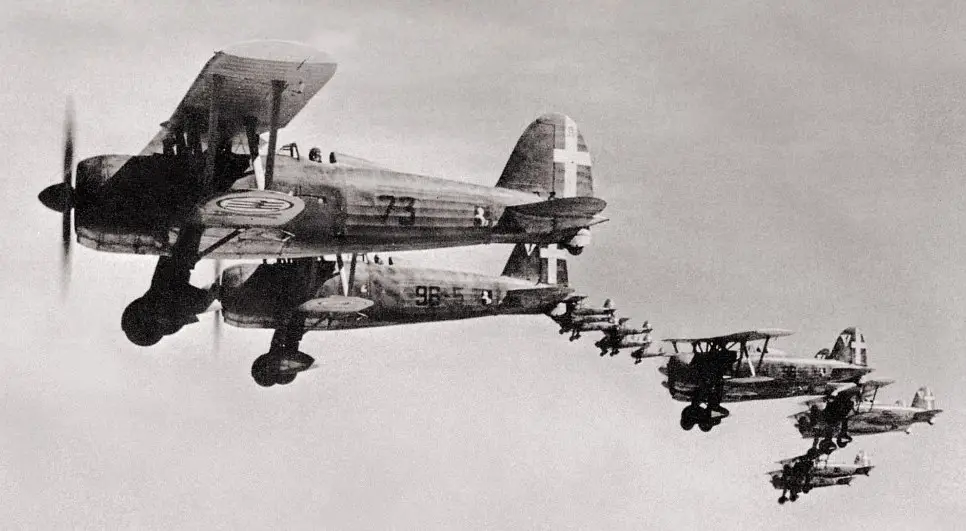
Fiat CR.42 – Italian fighter workhorse in 1940.
Mussolini already had two feet in the Balkans, one in the Dodecanese island group and the other in Albania, why would he want more? Underlying it all was Mussolini’s craving for something equal to the ancient Roman Empire. Considering his original political orientation as a young barn-storming socialist, hating bolshevism intensely, this is rather strange. A probable explanation is that power corrupts. Like Hitler, he was also urged on by the fear of premature death – if the mission was not fulfilled in his time, it would never be.
The Roman Empire took centuries to build. Mussolini was set on doing it in his lifetime. The Regia Aeronautica was central in Mussolini’s plans. It was a common denominator for modern Italy as he saw it. In East Africa and Spain, it had proven that it was equal to or better than any equipment that was set against it by the other great powers. And he wanted to be a no less man than his sometimes hero – Hitler.
Regia Aeronautica Composition
If we took a look at the relative air force compositions in the Mediterranean in June 1940, it looked quite good for Italy. France was their worst potential enemy in the air as British units were practically non-existent in Gibraltar and Malta. At the same time, they were only a little better off in Egypt and the Middle East. But, none of the two potential Italian opponents had their best forces stationed close to Italy. The Italian Air Force could, therefore, be said to be in a relatively favorable position regarding the upcoming war in the air. Let us take a look at the way the Italian combat units were positioned around the Empire:
The areas of responsibility of the Regia Aeronautica were organized in Squadra Aeras, Air Force sectors, somewhat akin to the German Luftflotten and the British Groups. Fighter, bomber, and reconnaissance units were assigned to the various Squadra Aeras according to need. In addition to the 3 Squadras (there were also specific territorial force compositions called Aeronautica – they can be compared with German Fliegerkorps or Allied Air Forces, for example, the RAF Desert Air Force.
These were:
1st Area: Milano – Novara, Caselle and Padua airfields
2nd Area: Palermo – Catania and Palermo airfields
3rd Area: Roma – Viterbo, Ciampino South and Bari
Sardinia Air Force: Cagliari – Cagliari airfield
Albania Air Force: Tirana – Tirana airfield
Libyan Air Force: Tripoli – Tripoli and Tobruk airfields (renamed 5th Area on 25 July)
Aegean Air Force: Rhodes
Zona Aerea Territoriale: (renamed 4th Area 30 December)
Africa Orientale Italiana (AOI): HQ Addis Abeba
Naval air units were organized in the following areas: The Adriatic, Thyrrenean Sea 1, Thyrrenean Sea 2, The Ionian Sea, Sardinia, Sicilia, The Aegean. In addition to the primary airfields in each Squadra, there were dozens of secondary airfields. As an example, in Squadra One – Milano – there were more than 20 military airfields, in Libya, approx. 20 and in East Africa (AOI) more than 40. The Italians took the infrastructure question seriously.
The major Italian tactical unit was the Stormo. The Stormo was composed of one or more Gruppi, which again consisted of one or more Squadriglie. There were variations in the composition of these units, as well as the numbers of planes in each. Therefore, a Stormo could consist of 12-50 planes, depending on allocation, serviceable planes, and the number of pilots available. The Stormo could be compared with the German Gruppe and the British Wing. A German (fighter) Gruppe would generally consist of 3 Staffeln, each with 12 planes. These were split into Schwarms, each of four planes. A British squadron would ideally consist of 3 Flights, each with six planes. The full nominal inventory was 16 planes. The Germans operated their Schwarms in two Rottes (each a pair of aircraft), while the British split their Flights into two Sections of three planes each. The German Gruppe normally also had a Gruppe Staffel of four planes. The British and German Wings and Gruppes were homogenously equipped as to aircraft type. In the early summer of 1940, the Italian Stormos were often composed of Gruppi with different plane types. Even with Gruppi with different Squadriglie types. Finally, independent Gruppi could be split into sezione of 2-4 planes.
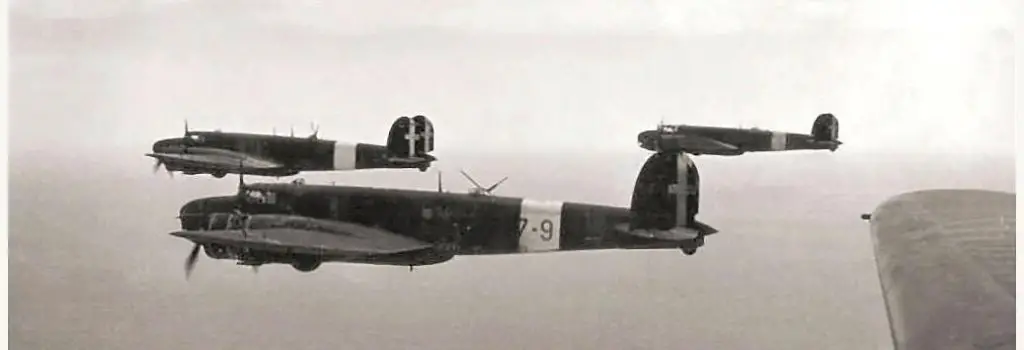
The Fiat BR.20 – a modern and well-balanced medium bomber.
Equivalent bomber units would generally be organized along the same lines but with a lesser number of planes. This goes for all nations mentioned here, the French, too.
Mitigating the Threat in June 1940
In WW2, as a whole, Italy has been judged by how the war developed in time. In the summer of 1940, however, there were positive indicators as to how the future could work out for Italy, and the RA was going to be an essential part of it. The Allies indeed feared it. Mussolini wanted to play it cool against the French. A wise move as the French, in mainland France and Tunis, were more on par with Italy than the British in the Mediterranean and Egypt. In Southern France, the Armee de l’Air had such modern fighter monoplanes as the Morane-Saulnier 406 and the Bloch Mb.152, even some Dewoitine 520s. At the same time, the British in Egypt depended mainly on the Gloster Gladiator biplane. This aircraft can be compared with the main Italian plane at the time, the Fiat Cr.42 Falco. But the Italians had many more of these than the British had Gladiators. The RA could fly against the RAF operational areas in North Africa from bases in Libya, Italy, Albania, Rhodes, Ethiopia, Eritrea, and Somaliland. The Italian bomber forces were even more impressive than their fighter branch with some of the most modern bombers at the time.
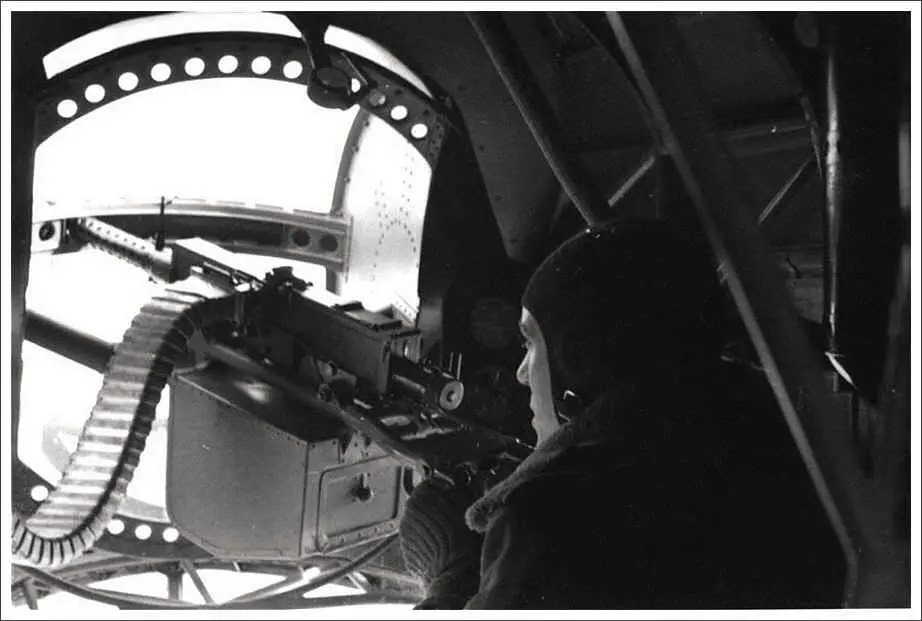
The Breda 12.7 mm. MG in the Fiat BR.20.
Giulio Douhet and Air Power
As was the case with both the French and British air forces, the Italian was very much influenced by Douhet’s theories, originating after WW1. Dunning writes:
“Douhet was an army officer who had commanded the prewar Italian Air Corps but had been court-martialled in 1916 for disagreeing with his superiors on the use of aircraft. By the end of the war, he was working in aviation administration and had been reinstated with the rank of General. By 1922 he had determined to concentrate on writing about the theories concerning the use of airpower. In 1927 he revised and reissued a book which became widely read and of seminal influence throughout the Western world – “Command of the Air.” The main thrust of his argument was that future victory in war would go to the nation, which could dominate the skies. The bombing of industries and cities would cause panic among the population who would force their government to surrender. Ground forces were considered as purely defensive. Fighter aircraft were dismissed, as bombers were to be self-defending and as fast, or faster, than the interceptors. At the time, this was a reasonable proposition, as the latest bomber types entering service in the late 1920s-1930s were capable of out-flying any interceptors. A case in point being the Fairey Fox, which was faster than anything else in RAF service at the time of its debut”
.
Related: Giulio Douhet: Early Proponent of Air Power
Both the British Sir Hugh Trenchard and Billy Mitchell, an American colonel, hooked on to these ideas, under Douhet’s slogan, “the bomber will always get through.” Colonel Mitchell staged some bomber demonstrations on obsolete, anchored, warships. The tests were scheduled for June and July 1921. While the ships were being assembled off the Virginia coast, Mitchell amassed an armada of airplanes as the 1st Provisional Air Brigade. He ordered exhaustive bombing practice against mock ships near Langley Field. Army ordnance personnel produced the new 2,000-pound bombs that would be needed to sink a battleship.
On Amazon: Courage Alone: The Italian Airforce 1940-1943
The tests began as scheduled, and the careful preparations paid off. The bombers first sank a former German destroyer, followed by a light armored cruiser and then one of the world’s largest war vessels, the German battleship Ostfriesland, followed by the US battleship Alabama – and later the battleships New Jersey and Virginia. As far as Mitchell and the press were concerned, the assertion that airpower should be the nation’s first line of defense had been proved. “No surface vessels can exist wherever air forces acting from land bases are able to attack them.” Mitchell declared.
The tests had a couple of serious flaws. The ships were lying still. There was no anti-air barrage to divert the aim or destroy the bombers and, somewhere in the back of my head, I mean to have read that Mitchell saw to that the water-sealing doors between the ship’s compartments were left open.
The Bomber
For aviation enthusiasts, it is easy to forget that in 1940 the bomber, with its capacity to deliver heavy ordnance and ability to exert damage on the enemy, was the primary air asset of any air force. The fighter, with its glorified aces, originated out of the WW1 scout planes as a means to deny the scout planes of the other side achieving their missions. As air bombing developed, the fighters’ primary purpose turned to be countering the enemy bombers or defending their own bombers against enemy fighters. Apart from that, the fighter could do little damage to enemy assets except in the ground-strafing role.
When the war started in 1939, the balance of power between bombers and fighters had just begun to shift. The newest, faster-than-bomber fighter designs were only just being introduced into the world’s air forces. Still, in the Mediterranean Theatre, with France just about being knocked out of the fight, the bombers, particularly the Italian bombers, were the kings. The RA had also understood the secondary potential of their fighter forces, the fighter-bomber. Both the Cr.42 and the Cr.32 had been tested in a ground support role, mainly in anti-personnel missions with small bombs. The battlefields in Ethiopia and Spain had been effective proving grounds. The fighting in Spain had also shown that even unsophisticated anti-air artillery systems could be deadly. If bombers were kings, the Savoia-Marchetti SM.79 was definitely the queen of the Italian bomber force in June 1940. To lead the Italian forces in North Africa was the incarnation of the large bomber formations himself – Italo Balbo.
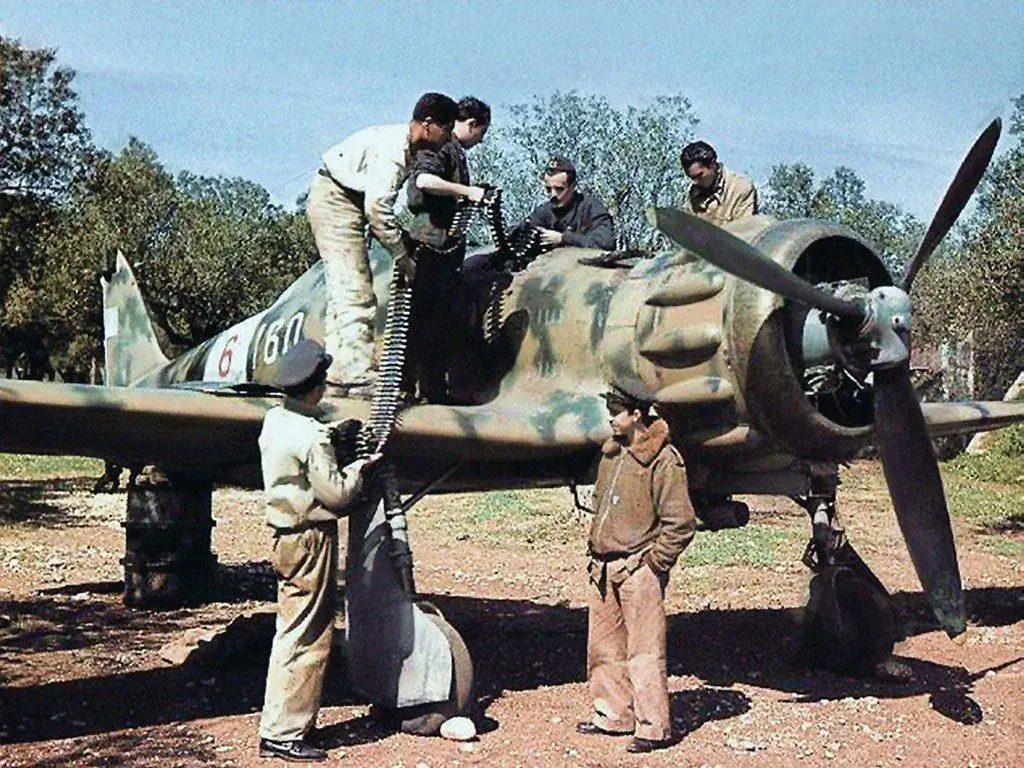
Ground crew adding ammunition to the C.200 Saetta.
Regia Aeronautica at Declaration of War
In June 1940, the leading Italian air threat against Southern France were the units belonging to Squadra Area 1 – Milano. Their primary mission was to support the Italian army units preparing to move into France and the reduction of the French naval bases and ships along the Mediterranean coast. A critical mission for the Sardinian Air Component was the cutting-off of French sea and air transports between its North African colonies and France. On 10 June 1940 Squadra Area 1 – Milano had the following force spread out on more than a dozen airfields:
40 Squadriglie in 20 Stormi + 1 independent Squadriglie with the following aircraft types:
90 RO 37 reconnaissance planes
113 Fiat BR.20 medium bombers
16 Caproni Ca.311 reconnaissance planes
81 Fiat CR.42
The Sardinian Air Contingent, operating from 5 different airfields:
17 Squadriglie in 8 Stormi + 1 independent Squadriglie with:
27 CR.32 fighters
17 CR.42 fighters
13 Ba.88 ground support aircrafts
62 SM.79 bombers
18 Cant Z.506 floatplane bombers
4 Ro.37 reconnaissance planes
To cover Malta and the central Mediterranean Squadra Area, two could muster, from 8 airfields:
30 Squadriglie in 14 Stormi:
26 CR.32 fighters
9 Ro.37 reconnaissance planes
14 S85 light bombers
177 SM.79 bombers
Against the French in Tunis and the British forces in Egypt, the Libyan Air Component had:
36 Squadriglie in 18 Stormi + 2 independent Squadriglie:
25 Ca.309 reconnaissance planes
24 Ca.310 light bombers
11 Ba.65 light bombers
25 CR.32 fighters
27 CR.42 fighters
27 SM.81 bombers
14 Ro.37 reconnaissance planes
8 SM.75 transports
99 SM.79 bombers
6 Cant Z.506 floatplane bombers
To cover the Eastern Mediterranean, the Aegean Air Component could field:
4 Squadriglie in 2 Stormi + 1 independent Squadriglie:
20 SM.81 bombers
11 CR.32 fighters
The Italian navy could muster ca. 80 floatplanes for reconnaissance, air-sea rescue, convoy escort, and day bombing along the Mediterranean, Adriatic, and Aegean Seas.
Against Egypt, the Red Sea and the British possessions in East Africa the Orient Air Component had:
30 Squadriglie in 11 Gruppi + 11 independent Squadriglie with:
36 SM.81 bombers
103 Ca.133 reconnaissance planes
12 SM.79 bombers
9 Ro.37 reconnaissance planes
18 CR.32 fighters
24 CR.42 fighters
Opposing the RA in North Africa was the RAF Middle East Command with its forces spread around in Egypt, Iraq, the Mediterranean (Malta), and Aden. In Egypt, the RAF had 202nd Group with five bomber squadrons – 3 with Blenheim and one each with Bombays and Valentias. No fighters, but the Middle East Command could draw on the other units in the Command, in all 29 squadrons with less than 300 aircraft.
Related: Regia Aeronautica Commanding Officers and Commands
Was Regia Aeronautica Prepared?
It is often stated that Italy was badly prepared for war in June 1940. That might be, but if we compare the air situation with the other nations, as it has been outlined here, Italy was not alone in this. Purely counting the forces available to all parties, I would rather say the opposite. However, there were apparent shortcomings in Italy’s ability to fight a prolonged war. The most critical factor being its lack of an industrial base to sustain usage and losses with the simultaneous need to develop improved weapons systems of any numbers as the war dragged on.
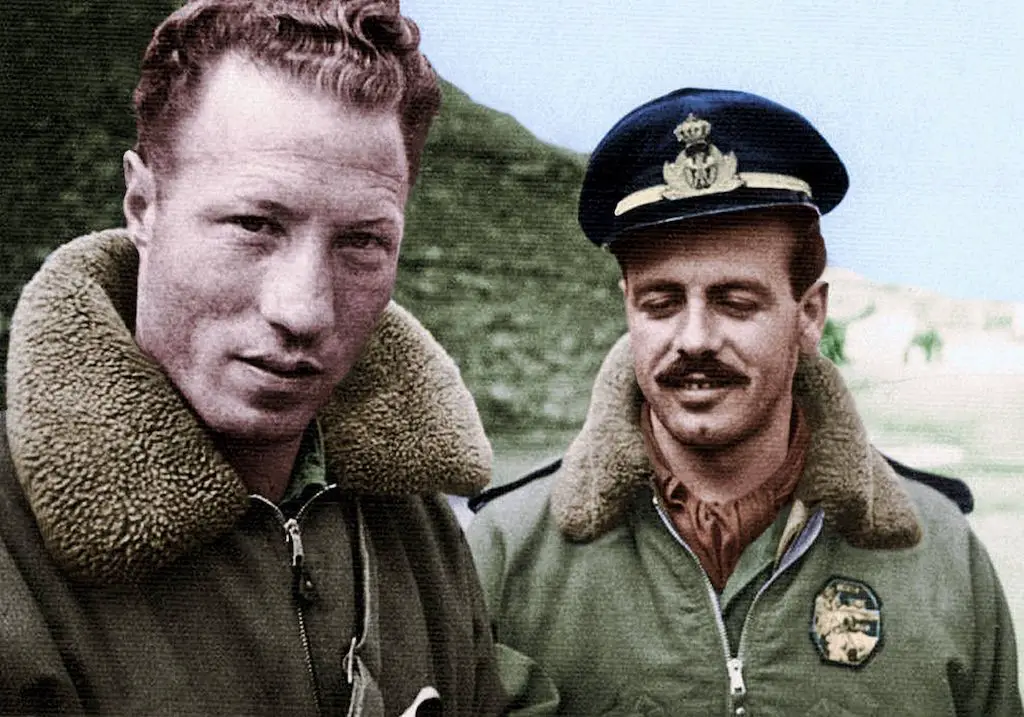
Two Regia Aeronautica pilots. Image: Reddit.
Not comparing aircraft types, a couple of specific weaknesses stood out. Communication radios in aircraft were virtually non-existent. The ground organization was poorly equipped with vehicles and servicing equipment such as tractors, fuel trucks, and loading trolleys. The ever-present machine gun was the Breda 7.9 and 12.7 mm’s. These were reliable weapons if with a relatively low rate of fire for air fighting use and with a lower muzzle velocity than the venerable Browning 12.7 mm. (.50 caliber).
That said, at the time, Italian bombers were alone in having such a heavy weapon for defensive purposes, excepting the French LeO 451. The RA fighters usually had only a pair of the 12.7 mm guns, positioned above the engine. A general weakness in their fighters’ wing constructions contributed to this.
Related: Regia Aeronautica OOB on 10 June 1940
The RA had an extensive training organization for pilots and technicians, and there was no lack of candidates for either of these categories. The pilot training syllabus had an unusual peculiarity in that after having finished the second stage, the final aerobatic training was to be done at squadron level with squadron instructors, resulting in non-standard final training. Much emphasis was put on aerobatics with minor resources used on live firing or more cost-effective use of their war machines. This necessarily had to result in a sort of “on-the-job-training.” It is said that training in deflective shooting was virtually non-existent.
Mussolini would listen to no protestations against entering into war: “The war shall last no more than three months.”